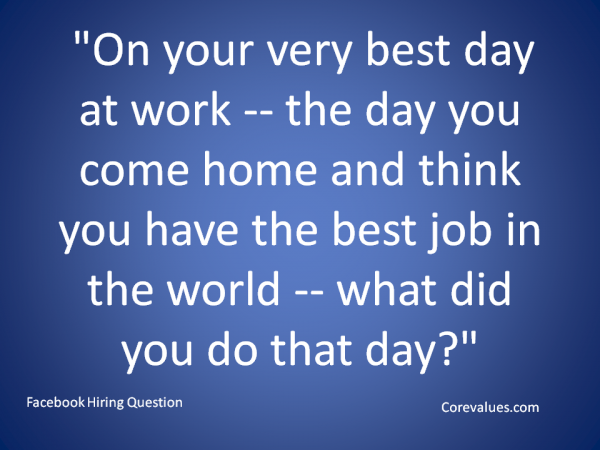 As a leader, you are only as good as your team. Therefore, most leaders strive to attract and hire top talent for their organizations by recognizing employee qualities needed to enhance cooperation among employees and collaboration between departments for enhanced revenue, purpose and impact.
As a leader, you are only as good as your team. Therefore, most leaders strive to attract and hire top talent for their organizations by recognizing employee qualities needed to enhance cooperation among employees and collaboration between departments for enhanced revenue, purpose and impact.
It makes sound business sense to do so.
According to Gallup research, organizations that hire individuals within the top 20 percent of the applicant pool benefit from a 20 percent increase in sales, 10 percent increase in productivity and a 30 percent increase in profit. On top of these increased revenue benefits, organizations also benefit from cost savings. These include a 25 percent decrease in unscheduled absences and a 10 percent decrease in turnover rates.
Revenue improvement doesn’t stop there.
Once these talented employees are in their positions, leaders who reinforce the TIGERS® 6 Principles of trust, interdependence, genuineness, empathy, risk and success to engage employees on all levels also benefit from a 21 percent increase in productivity, as well as a 22 percent in profitability. With all the benefits of hiring top talent, it’s no wonder that many leaders are so concerned with their hiring decisions.
Therefore, how do you find, attract and identify top talent for your company? The answer lies in implementing an employee value proposition plan and creating a hiring strategy.
Company team building tactics to hire the right candidates that resonate with trust, interdependence, genuineness, empathy, risk and success.
The following company team building tactics assist leaders in learning how to hire the right candidates for their organizations.
Focus on your EVP.
Your EVP, or employee value proposition, is your plan for the benefits and rewards that you will offer employees. In order to attract top talent, leaders need to understand who the top talent is in their industry. They also benefit from applying empathy to understand what these candidates are looking for from a company. For example, companies might offer employees school loan pay off benefits. They might provide housing allotments so employees don’t have to drive over 10 miles to get to work. Or, companies might offer employees paid tuition for upward mobility and career enhancement. Talented employees are likely looking for these types of benefits.
When drafting an EVP, leaders also need to remain competitive in the market. Knowing what other companies in the industry are offering their employees is important research. Leaders then need a way to differentiate themselves from their competition. If every company offers the same benefits, top talent is likely to look at several companies for employment. Instead, set your company apart by reasoning through benefits that promote trust, interdependence, genuineness, empathy, risk resolution and success in the workplace.
Give yourself time.
It makes common sense that the more urgent your need for a new hire, the less picky you’ll end up being. This can affect the caliber of candidate that you hire.
Failing to take the time to assess culture fit and values match can result in wasted time and revenue. While turnover can be unpredictable resulting in a desperate need to fill the role, take as much time as you possibly can to hire the best candidate. Ideally, you will know in advance that a team member will be leaving their position, which gives you time to fill their role.
In an emergency, you should already have your eye on potential candidates. Ask you employees if they know of people who would fit well into the culture and who have superior skills and work ethic to fill a vacating role. Employees who recommend candidates are often the best mentors for new employee onboarding, which serves several purposes. It helps the new employee fit into your work environment faster. It saves on executive search fees though organizations that do not understand your culture fit expectations and are simply matching on resume and past experience. It gives your existing employees a felt sense of satisfaction that their good relationships make a difference and contribute to the growth of their organization, too.
Look for the right skills.
Small companies usually don’t have different employees to fill all the essential roles of the organization. Instead of hiring into roles, leaders can look for candidates who possess the essential skills that they need. The five important roles that need to be filled include PR and Marketing; Payroll and HR; Maintenance; IT and Tech; and Financial and Accounting. If your small company doesn’t have room for five different people to fill these roles, look for people who possess some of these skills and outsource expertise when needed.
Look for potential.
Experience is a necessary part of the hiring process. However, not every candidate can possess the ideal experience. Instead, look for candidates who possess potential along with good communication, problem solving and conflict resolution experience. These are candidates who are reliable, passionate and willing to take accountability and ownership for their own actions. You can train them in the technical skills needed for your company if their past experience is translatable into what they will be required to do.
Dig deeper.
The hiring process is a great time to learn about your potential candidates. Leaders benefit from taking the time to ask as many probing questions as possible. One of the best probing questions asked by Facebook Human Resource teams is, “On your very best day at work — the day you come home and think you have the best job in the world — what did you do that day?” A candidate’s answer tells you tons about what gives that candidate passion and happiness.
How you hire talented people makes all the difference for any organization. In fact, the right employees increase your revenue making it possible to offer flexibility in your pay for performance perks down the road. With so much at stake, learning what behaviors you are looking for that enhance workforce trust, interdependence, genuineness, empathy, risk resolution and success is the first step. Then developing your EVP; giving yourself time to interview and weed through candidates; looking for skills and potential rather than experience; and digging deeper during the interview to properly assess candidates are strategies to deploy. These strategies help leaders attract and identify top talent for their organizations.
Here are some additional resources to add value to this topic:
• What Attracts the Best Employees to a Company?
• 4 Must-Know Factors That Influence Your Hiring Decision
• The 5 Essential Hires Needed to Grow a Business
• 3 Hiring Trends for 2016 and Beyond
• 8 Costly Mistakes to Avoid When Interviewing a Job Candidate
Copyright TIGERS Success Series, Inc. by Dianne Crampton
About TIGERS Success Series, Inc.
TIGERS Success Series is a Bend, Oregon Leadership and Team Improvement Consultant that helps committed leaders build more cooperation among employees and collaboration between departments for improved growth, revenue, purpose and impact.
We do this by deploying the TIGERS team process that improves workforce behaviors that are anchored by trust, interdependence, genuineness, empathy, risk resolution and success. Providing diagnostics and customized team interventions, you can improve both work culture and transform your adequate teams into exceptional ones. We also license and train HRD Executives, Project Managers, Managers, Trainers and Team Consultants in the use of our award winning resources. For more information, call 1+ 541-385-7465.
